Leon Neal/Getty Images News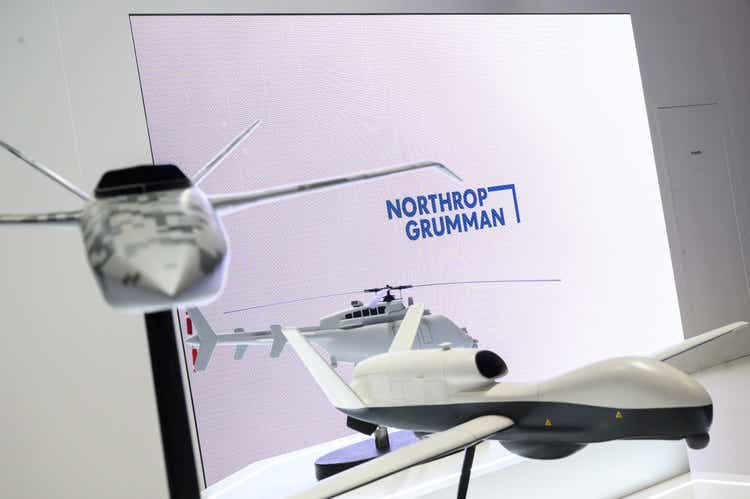
I first highlighted Northrop Grumman Corporation (NYSE:NOC) in a Seeking Alpha Quick Pick & Lists article about the aerospace and defense industry on March 25, 2022.
I heeded my advice and conducted further due diligence. As a result, NOC was the lone survivor using my most conservative screening parameters that seek quality enterprises currently trading at reasonable stock prices.
In this primary ticker follow-up research report, I put the company and its common shares through my market-beating, data-driven investment research checklist of the value proposition, shareholder yields, fundamentals, valuation, and downside risk.
The resulting investment thesis:
In an unpredictable world, a strong defense is a necessary evil to fight evil when it arises which seems every few decades or so. NOC stands out as a fundamentally strong, below average risk defense contractor whose common shares are currently trading at a reasonable price.
My current overall rating: Buy.
Unless noted, all data presented is sourced from Seeking Alpha and YCharts as of the market close on June 13, 2022; and intended for illustration only.
Trouncing the Industry, Sector, and Market
Northrop Grumman Corporation is a dividend-paying large-cap stock in the industrial sector’s aerospace and defense industry. The company operates globally through four segments: aeronautics systems, defense systems, mission systems, and space systems. Northrop Grumman was founded in 1939 and is headquartered in Falls Church, Virginia.
The chart below illustrates the stock’s performance during the past ten years against the iShares U.S. Aerospace & Defense ETF (ITA), the Industrial Select Sector SPDR Fund ETF (XLI), and the SPDR S&P 500 Trust ETF (SPY). Ultimately, investing in individual common stocks should aim to beat the benchmark indices over time. For example, NOC has trounced the industry, sector, and market performances.
My value proposition elevator pitch for the Northrop Grumman:
Elections, periods of peacetime, and budget limitations notwithstanding, being an entrenched member of the military-industrial complex has the long-term benefits of predictable if incremental growth and steady profit margins leading to broader market outperformance.
My value proposition rating for NOC: Bullish.
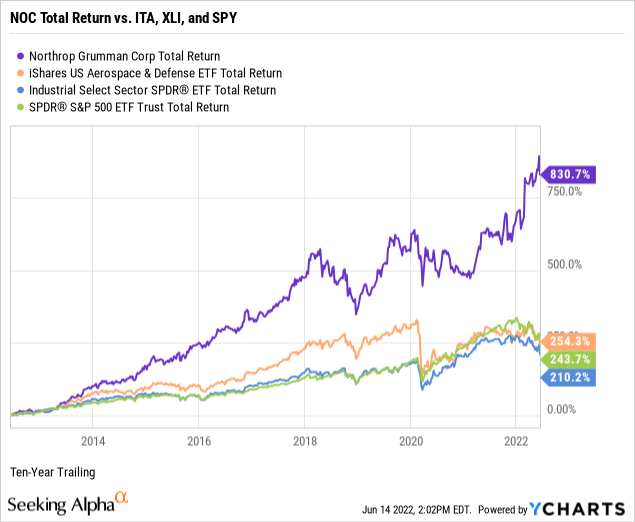
Outperforming the 10-Year, Although Barely
As part of my due diligence, I average the total shareholder yields on earnings, free cash flow, and dividends to measure how a targeted stock compares to the prevailing yield on the 10-year Treasury benchmark note. In other words, what is the equity bond rate of the common shares?
I target an earnings yield greater than 6 percent or the equivalent P/E multiple below 17 times, and Northrop Grumman exceeded the floor at 8.01%, as demonstrated in the chart below.
I target a free cash flow yield of 7 percent and higher or the equivalent of fewer than 15 times the inverted price-to-free cash flow multiple. At 2.35%, NOC does not exceed the threshold.
Although not a dividend investor by definition, I prefer dividend-paying stocks for compensation in the short term while waiting for capital gains to compound over time. Northrop Grumman offers a moderate dividend yield of 1.43% with a 24.97% payout ratio, below my 60% payout ratio ceiling, thus indicating a safe, well-covered dividend.
Next, I take the average of the three shareholder yields to measure how the stock compares to the prevailing yield of 3.45% on the 10-year Treasury benchmark note. The average shareholder yield for NOC was 3.93%. Arguably, equities are deemed riskier than U.S. bonds. However, securities that reward shareholders at higher yields than the government benchmark, such as NOC, if barely, favor owning the stock instead of the bond.
Remember that earnings and free cash flow yields are inverses of valuation multiples and suggest the NOC may be fairly valued. I’ll further explore valuation later in this report.
My shareholder yields rating for NOC: Bullish.
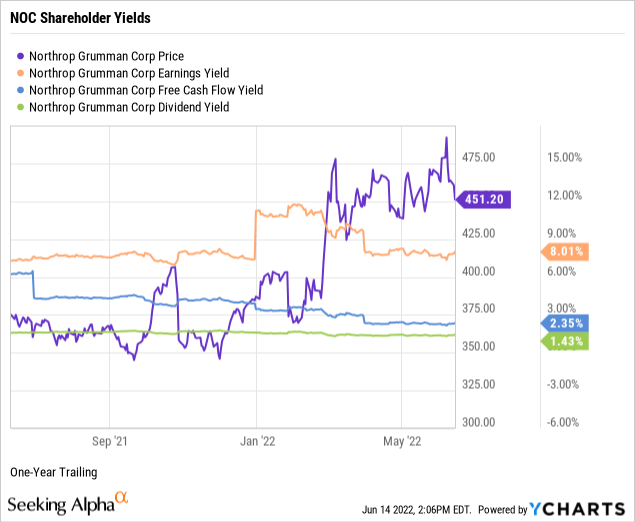
Outstanding Returns on Equity and Capital
Let’s explore the fundamentals of Northrop Grumman, uncovering the performance strength of the company’s senior management.
When analyzing a business, I am biased toward established growth instead of executive guidance and sell-side analyst projections. For example, per the below chart, Northrop Grumman had three-year revenue growth of -3.93% vs. a median of 6.07% for the industrials sector. The company’s low-single-digit negative growth was perhaps from a contraction in sales in the post-Iraq and Afghanistan era.
Northrop Grumman had a trailing three-year pre-tax net profit margin of 16.33%, exceeding the sector median net margin of 6.69%. I screen for profitable companies to avoid unnecessary speculation, as witnessed in the money-losing disruptive growth stocks.
Return on equity or ROE reveals how much profit a company generates from shareholder investment in the stock. I target an ROE of 15 percent or higher to discover shareholder-friendly management. NOC was producing extraordinary trailing three-year returns on equity of 48.59% against a median of 14.31% for the sector.
I target a return on invested capital or ROIC above 12%. Northrop Grumman at 23.38% exceeds the threshold, indicating that senior executives are highly efficient capital allocators. Return on invested capital measures how well a company uses its resources to generate excess returns. On the contrary, returns market-wide appeared challenged during the pandemic.
ROIC needs to exceed the weighted average cost of capital or WACC by a comfortable margin, giving management’s ability to outperform its capital costs. NOC had a trailing WACC of 6.47% (Source: GuruFocus).
Top line growth issues notwithstanding, the ample spread between ROIC and WACC combined with positive net profit margins and compelling equity and capital returns indicate adequate management performance at Northrop Grumman.
My fundamentals rating for NOC: Bullish.
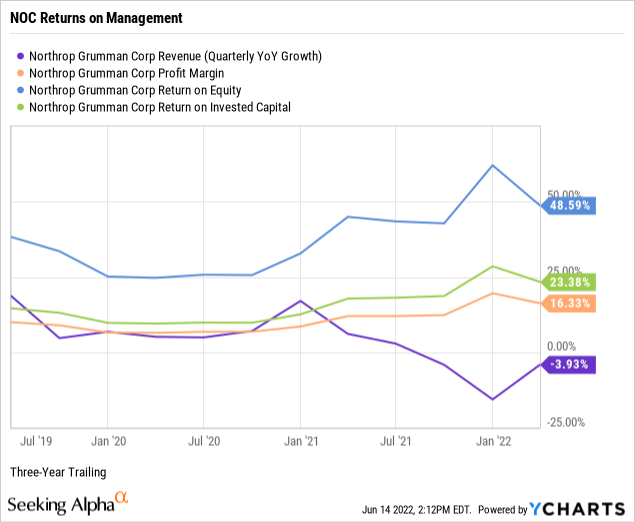
Stock Appears Underbought by the Market
I rely on four valuation multiples to estimate the intrinsic value of a targeted quality enterprise’s stock price.
The price-to-sales ratio or P/S measures the stock price relative to revenues. I target fewer than 2.0 times, and at 2.03, NOC was trading at the ceiling. In addition, the trailing P/S ratio was 1.32 for the industrials sector and 2.53 times sales for the S&P 500. Thus, the weighted industry plus market sentiment suggests the stock is reasonably valued relative to the company’s top line.
Although often a hit or miss multiple, I target price-to-trailing earnings or P/E multiples fewer than 17 times or below the target stock’s industry and sector averages. NOC had a price-to-earnings multiple of 12.45 against a sector P/E of 17.76, indicating investor sentiment undervalues the stock price relative to earnings per share. Further, the stock was trading at a discount to the S&P 500’s recent overall P/E of 21.54 (Source of S&P 500 P/E: Barron’s).
I target single-digit price-to-operating cash flow multiples for the best value. At 22.78%, NOC was trading above my ceiling and the sector median of 15.66, indicating the market places a premium on the stock price relative to current cash flows.
Enterprise value to operating earnings or EV/EBIT measures whether a stock is overbought, a bearish signal, or oversold, a bullish signal, by the market. I target an EV/EBIT of fewer than 15 times. Against the broader sector median of 16.18, NOC traded at 10.82 times EV/EBIT, signaling the market has underbought the stock.
The weighting of my preferred valuation multiples suggests that the market has reasonably valued the stock price. Therefore, based on the fundamentals and valuation metrics uncovered in this report, risks and potential catalysts notwithstanding, I would call NOC the fair-priced, perhaps underbought stock of a quality operator within the aerospace and defense industry.
My valuation rating for NOC: Bullish.
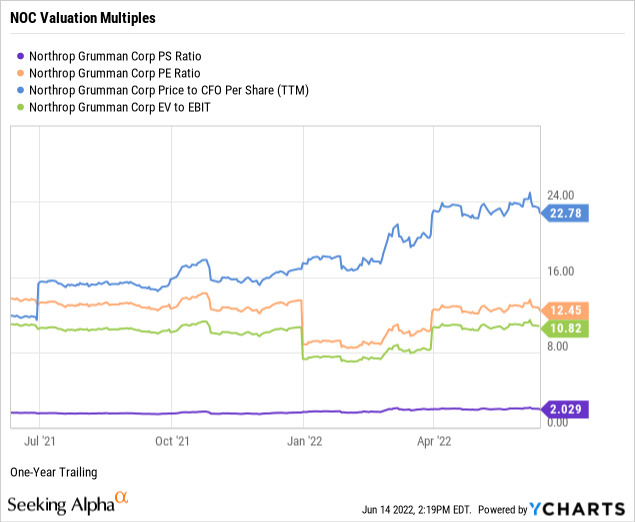
Wide Moat, Below Average Downside Risk
When assessing the downside risks of a company and its common shares, I focus on five metrics that, in my experience as an individual investor and market observer, often predict the potential risk/reward of the investment. Hence, I assign a downside risk-weighted rating of above average, average, below average, or low, biased toward below average and low-risk profiles.
Alpha-rich investors target companies with clear competitive advantages from their products or services. An investor or analyst can streamline the value proposition of an enterprise with an economic moat assignment of wide, narrow, or none.
Morningstar assigns Northrop Grumman a wide moat rating (bulleted emphasis is mine):
- We believe that Northrop’s aeronautics segment has a wide moat, as it has exposure to several highly prioritized long-cycle programs, particularly in its manned aircraft subsegment.
- We believe the missions systems segment is wide-moat, based on product complexity preventing new entrants from developing competing products, and switching costs stemming from the cost of failure and the fact that many of these products are already well integrated into long-cycle platforms.
- We think the space systems segment has a wide moat. This segment largely produces satellites and sensors for satellites.
- We believe the defense services segment has a narrow moat, based on a much shorter product cycle and a larger array of potential competitors.
– Burkett Huey, CFA, Equity Analyst, April 28, 2022
A favorite of the legendary value investor Benjamin Graham, long-term debt coverage demonstrates balance sheet liquidity or a company’s capacity to pay down debt in a crisis. Generally, at least one-and-a-half times current assets to long-term debt is ideal. However, as reported on its March 2022 quarterly financial statements, Northrop Grumman’s long-term debt coverage at 0.90% was under the threshold.
Thus, the company lacks the ample liquidity necessary to cover at least 100% of its longer-term leveraging needs. However, in a further test of paydown capacity, NOC’s long-term debt to equity was 109.02%, about half my 200% ceiling. In other words, investors should become concerned only when a company’s debt is more than twice its equity.
Current liabilities coverage or current ratio measures the short-term liquidity of the balance sheet. I target higher than 1.00, and NOC’s short-term debt coverage was 1.31. Thus, the balance sheet provides sufficient liquid assets to pay down its current liabilities, such as accounts payable, accrued expenses, income taxes, and unearned revenue.
As a long-term investor, I use a five-year beta trend line and screen for stocks lower than 1.25 or no more than 125% volatility in the market. NOC’s trailing beta was a low 0.67. And its 24-month beta is lower at 0.46. With price volatility below the S&P 500 standard of 1.00, this defense contractor is a relatively safe holding across market cycles.
The short interest percentage of the float was 1.33% for NOC, well under my 10% ceiling. Perhaps the near-sighted bears view the stock as a wide-moat industrial staple in institutional and retail portfolios.
Overall, Northrop Grumman is a fundamentally sound company with an attractive risk profile, in my view.
My downside risk rating for NOC: Below Average.
Catalysts and Final Thoughts
Catalysts confirming or contradicting my overall bullish investment thesis on Northrop Grumman Corporation and its common shares include, but are not limited to:
- Confirmation: Northrop Grumman’s wide moat and total return dominance in an unpredictable and historically war-torn world keep defense department orders and taxpayer-fueled profits infinite.
- Contradiction: The company doesn’t improve free cash flow pricing performance nor gets current assets above long-term debt, the only two dings in this report.
Of the four defense contractors that initially appeared on my quality value investing screen, NOC stands out after further research. Own a slice of Northrop Grumman for its strength in fundamentals and below-average downside risk combined with the stock’s history of soundly defeating its industry, sector, and market in total returns.



Be the first to comment